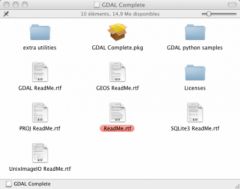GTOPO30, completed in late 1996, was developed othrough a collaborative effort led by the U.S. Geological Survey’s Center for Earth Resources Observation and Science (EROS). GTOPO30 is a global digital elevation model (DEM) with a horizontal grid spacing of 30 arc seconds (approximately 1 kilometer).
Gtopo30 is provided in tiles. Here is how to mosaic them into a single mosaic. First download from GTOPO30 the tiles you need to mosaic. Then write a script like the one I describe below (save it and change its permission to make it executable, chmod u+x make_gtopo30.sh)
First let’s define parameters.
inDir=/Volumes/TimeMachine/data/gtopo30/in
outDir=/Volumes/TimeMachine/data/gtopo30/out
outFile=$outDir/gtopo30_global.tif
tmpDir=/Volumes/TimeMachine/data/gtopo30/tmp
# ensure outDir and tmpDir are created
mkdir -p $outDir
mkdir -p $tmpDirYou must adapt those variables to the actual places where you saved the tiles (inDir), and where you want to have the result saved (outDir) and the temporary directory (tmpDir).
Then extract all files, with tar xvf (x=extract, v=verbose, f=file). tar command is a bit dull or old fashion. To force it to extract files into tmpDir while the tar files are in inDir, I saved the current directory (orgDir=$(pwd)) then moved to the target dir (tmpDir) and once all extracted, returned to the original directory:
orgDir=$(pwd)
cd $tmpDir
for tarFile in $inDir/*.tar
do
tar xvf $tarFile
done
cd $orgDir
Now, we are ready to build a mosaic. First get names of the files to process: DEM files have the .DEM extension. Save the list of these files into a variable, and pass it to gdal_merge.py
fileList=$(ls $tmpDir/*.DEM)
gdal_merge.py -o $outFile -of gtiff -co "compress=lzw" $fileList
Job done! Do not forget to delete the temporary directory
\rm -r $tmpDir
For a global mosaic, I ended with a 2.2Gb file (with internal compression). You can of course force the output resolution by using the -ps option in gdal_merge.py.
You can download the script from here.

